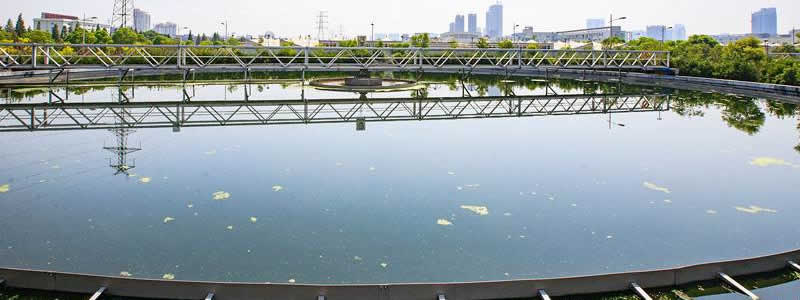
Flocculants & Coagulants
Flocculation and coagulation treatment chemicals are used in effluent wastewater water treatment processes for solids removal, water clarification, lime softening, sludge thickening, and solids dewatering.
Coagulation treatment neutralizes the negative electrical charge on particles, which destabilizes the forces keeping colloids apart. Water treatment coagulants are comprised of positively charged molecules that, when added to the water and mixed, accomplish this charge neutralization. Inorganic, organic, or a combination of both coagulant types are typically used to treat water for suspended solids removal.
When an inorganic coagulant is added to water containing a colloidal suspension, the cationic metal ion from the coagulant neutralizes the negatively charged electric double layer of the colloid. Much the same occurs with an organic coagulant, except the positive charge most commonly comes from an amine (NH4+) group attached to the molecule. Angchao has both flocculation and coagulation products. Examples of Angchao coagulation products include aluminum salts, iron salts, and polyelectrolytes.
How do flocculation chemicals work?
Flocculants gather the destabilized particles together and cause them to agglomerate and drop out of solution. Examples of Angchao flocculants include low-, medium-, and high-molecular weight polymers.
Discover how Angchao's water treatment coagulants and flocculants achieve optimal effluent results:
Organic Coagulants
For certain water sources, organic coagulation is more appropriate for solid-liquid separation. Organic coagulant is generally used when a reduction in sludge generation is desired. Furthermore, blended organic and inorganic chemicals are often more effective than either organic or inorganic chemicals alone. The correct blend can often combine the advantages of using the inorganic coagulant sweep-floc mechanism with the sludge generation reduction characteristics of the organic coagulants. Angchao's formulations are based on the following chemistries:
Polyamine and PolyDADMAC
These are the most widely used classes of organic coagulation chemicals. They function by charge neutralization alone, so there is no advantage to the sweep-floc mechanism. Polyamines will generally treat higher turbidity raw water (approximately >20 NTU) effectively. Polyamines are also effective in treating many types of wastewater. PolyDADMACs are a specific class of polyamines that fit in this category.
Melamine Formaldehydes and Tannins
These all-organic polymers act similarly to the inorganic coagulant products in that they not only coagulate the colloidal material in the water, but also contribute their own precipitated floc. This sweep-floc precipitate readily adsorbs organic materials such as oil and grease. The precipitate generally dewaters to low moisture concentration, making this choice of coagulant particularly well-suited to unit operations that generate hazardous sludge, such as DGF and IGF units in oil refineries. This self-precipitating chemistry is generally significantly more expensive to use than inorganic coagulant chemistry, but it can be economical when sludge removal and disposal costs are factored in.
Inorganic Coagulants
Inorganic coagulation is both cost-effective and applicable for a broad variety of water and wastewater. Inorganic coagulant treatment is particularly effective on raw water with low turbidity (total suspended solids concentration) and will often treat this type of water when organic coagulants cannot.
Once added to water, inorganic coagulant chemicals react with the alkalinity and hydrate to form metal (aluminum or iron) hydroxide precipitates, which act as a sweep-floc mechanism. This mechanism can be compared to snowfall on dirty air. As the snow falls, it adsorbs particulates in the air, which coprecipitate, thus cleaning the air. In water treatment, the metal hydroxide sweep-floc acts on water the way a snowfall acts on air. Many difficult-to-treat colloidal suspensions can be effectively treated using inorganic coagulants.
Although the metal hydroxide precipitate sweep-floc is advantageous in water cleaning, these precipitates add to the overall sludge volume that must be treated and removed. These precipitates also tend to lower the overall density and dewaterability of sludge versus precipitates created with organic coagulants. For influent or raw water applications where the sludge is generally non-hazardous, the penalty for creating more sludge with higher water content is small. For wastewater applications with hazardous sludge, the economic penalty can be significant.
Aluminum Sulfate
Alum is mildly hazardous with similar health effects and corrosion characteristics as diluted sulfuric acid. It is manufactured as a liquid, and the crystalline form is dehydrated from the liquid. Alum is one of the most commonly used water treatment chemicals in the world.
Aluminum Chloride
Generally, aluminum chloride works similarly to alum, but is usually more expensive, hazardous, and corrosive. Because of this, it is normally a distant second choice to alum. Angchao has aluminum chloride available as a liquid.
PACl & ACH
Angchao has a portfolio of varying combinations of Polyaluminum Chloride (PACl) & Aluminum Chlorohydrate (ACH) engineered for the basicity of your water.
Ferric & Ferrous Sulfate
Iron coagulation works similarly to aluminum coagulants but the cost may vary based on the local supply source. Ferric sulfate is the more commonly used, but ferrous sulfate is typically used in applications where a reducing agent or excess soluble iron ions are required.
Ferric Chloride
Ferric chloride is generally the least expensive inorganic coagulant, because it is generated as a waste material from steel-making operations (waste “pickle liquor”). However, it is by far the most corrosive and hazardous inorganic coagulant, and its use is limited to facilities equipped to handle it safely.
For more information, please contact:
TIAN@CHEM.NET
 Previous
Previous  Next
Next Get answers and advice from people you want it from.